This is one of those posts where I will come off as a lush, and an opinionated one at that. But these cocktails? They are simply research, baby – this is all for you.
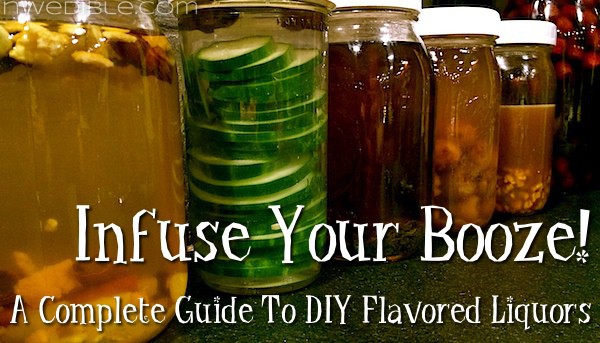
Infuse Your Booze
If you like the creativity of cooking and combining flavors and you drink hard alcohol then booze infusions are a natural place to play around and have fun personalizing your liquor cabinet. Infusions are also a great DIY holiday gift if your crowd is a little more scotch and speakeasy than santa hat and sugar cookie.
Booze infusions are very simple – you soak ingredients in a base alcohol until you like the taste. If you can make tea you can make a cucumber gin or a chai tea vodka or a cherry bourbon. Once you have those infusions on hand, you’re some ice and a mixer or two from a Cucumber Gin Gimlet (very refreshing in late August) or a Chai White Russian or a Cherry Manhattan.
That’s really all there is to it, so if you learn best by doing, feel free to stop reading now and go play around with whatever’s in your liquor and spice cabinet. I won’t take it personally. If you want the complete guide to everything I’ve learned about making my own infusions, read on.
Part One: Know Your Base Alcohol
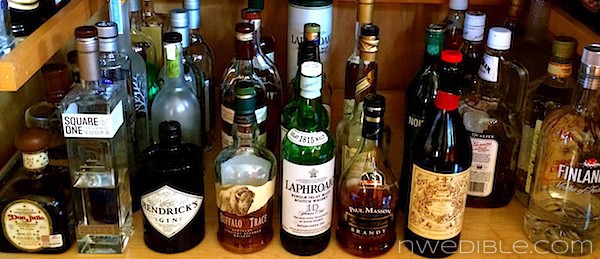
Your base is the booze that you’re going to flavor. I recommend a nice mid-shelf, mid-price alcohol. Top shelf isn’t necessary, but no infusion ingredients will make terrible rot-gut booze taste like anything other than a drain cleaning solvent, so find a comfortable middle ground of price and quality.
With all base liquors, the higher the proof, the more extraction power you’re looking at. So an overproof gin or bourbon will pull more flavor from your infusion ingredients than an 80 proof version. If you are looking for maximal extraction of volatiles, as for a medicinal or culinary extract, 190 proof Everclear may be of use. I haven’t worked with the super-overproofs, but if you can speak to their use in infusions, please chime in!
Vodka
A decent vodka is notable for it’s lack of flavor, which makes vodka the perfect beginner’s base for infusions. You can see this at a commercial level in the liquor section, where things like cotton candy vodka, bubblegum vodka, marshmallow vodka and other My Little Pony flavored spirits take perfectly good shelf space away from single malt Scotch.
Ignoring the flavor evil that’s being done in the name of commercial flavored vodkas, this neutral spirit plays extraordinarily well with most infusion ingredients, and is highly mixable as a spirit. For folks who see little point in drinking something basically flavorless, infusions can give vodka life. For all these reasons, if your heart isn’t already set on a particular non-vodka base creation, I recommend that you start your infusion experiments with vodka.
Classic infusion flavors: anything and everything. There are no limits to what you can infuse in vodka. Bacon? Dill Pickle? Oatmeal? Bacon-Dill-Pickle-and-Oatmeal? You name it and someone has done it.
Personal favorites: I typically infuse Findlandia but recently tried the Kirkland Signature American vodka at Costco. For the price, I think it’s unbeatable. I particularly like infusions of coffee and vanilla bean, fresh cherry, citrus of all kinds, ginger and dried pear, and many variations of “spiced.”
Gin
The cocktail lover’s booze, gin is a mix of herbs and botanicals typically distilled with neutral grain alcohol (vodka). To people like me, this makes gin something like “vodka with a point” because the spirit has a substantial flavor punch all on its own, or in minimalist concoctions like the martini (which, unless specified, should be made with gin and vermouth and ice and nothing else).
This does make gin slightly trickier to work with from an infusion standpoint. Add in the diversity of flavors in gin – that mix of botanicals varies by brand and can range radically in make-up and complexity – and you have a base that requires a bit more thought to infuse. The good news is, gin was meant to be mixed, and if you think about the type of gin mixed drinks you like to drink and what would be appropriate garnishing flavors, you’ll be led to infusion combinations that make sense.
Classic infusion flavors: cucumber, citrus of all kinds, floral (lavender especially), herbal – think basil, fennel or lemon verbena – apple and pear, and green tea.
Personal favorites: I infuse Gordan’s Gin. I love cucumber and star anise – this makes a simply lovely drink served neat over ice. Grapefruit and ginger is excellent too.
Tequila
Blanco is unaged with a typically straight forward flavor. It is a good choice for infusing with bold and assertive flavors that might overwhelm more subtle, aged tequilas. Gold tequila is Blanco with a little caramel color added, typically. Reposado has been aged less than a year in oak and is a bit smoother than Blanco. Anejo is aged over a year and is more smooth yet. The lighter the tequila the more adaptable it will be to a diversity of flavor infusions. Complex anejos require a more careful hand so that the more subtle flavors of the base are enhanced, not overwhelmed.
Classic infusion flavors: Chili, citrus, tropical fruit, coconut, ginger, melon, watermelon. The sweet herbs like mint, lemon verbena and cinnamon basil are also good.
Personal favorites: I’m not a big tequila drinker, but I’ve done a few infusions that are making me reconsider. I infuse in Sauza typically, or whatever relatively inexpensive tequila we have on hand for other use. I’ve done strawberry-mint and dried mango and lime and enjoyed them both.
Rum
Like tequila, rums vary from clear in color and straightforward in flavor to dark, stronger and more complex tasting. And like tequila, the lighter the rum, the more adaptable it will be to infused flavors, with the more complex and darker rums requiring a bit more thought in flavor pairing.
Rums seem to be second only to vodka in flavor bastardizations (banana rum, coconut rum, apple rum, etc.) and the purist in me must advise that you stay away from commercially made, artificially-flavored concoctions like these. However, DIY infusion versions made with real ingredients can be lovely. Soak fresh pineapple in a decent rum for week and tell me if you don’t agree.
Spiced rum is interesting, in that it is already (ostensibly) an infusion. While there are a some quality commercial spiced rums out there, most run overly sweet to my taste, a low quality base rum tarted up with artificial flavors. But spiced rum can give the DIY infuser a lot of inspiration.
Classic infusion flavors: Typical spices that play well with golden or aged rum are vanilla, cinnamon, nutmeg, allspice, ginger, cloves, pepper and citrus peel – the kind of tropical spices that grow in the same latitudes as sugarcane, rum’s parent plant. For white rum, citrus, particularly lime, is a great pairing, as are tropical fruits like pineapple, mango, lychee, coconut, etc. If you like strawberry daiquiris, consider a fresh strawberry rum infusion.
Personal favorites: Bacardi Light Rum or Don Q Cristal take infusion flavors very well, but I occasionally play around with darker rums too. Fresh pineapple with a little mint in rum is wonderful, and if you can find dried young coconut (typically available sweetened), you can make yourself the kind of coconut rum that even single malt girls like me can support. Vanilla-Orange is a personal favorite with a dark rum. Don’t let the vanilla bean take over and try it in a Dark and Stormy.
Brandy
Brandy doesn’t seem to get a lot of press, which is too bad, since it plays so well with others. In cocktails, desserts and savory cooking, brandy is a spirit that rarely fights. Fruit, spice and anything non-vegetal will work with this base. Brandies are made from grapes unless otherwise noted, and are typically aged in wood casks from two to six years or more. The longer the aging, the more complex the alcohol (and the more expensive). American brandy offers a good value. Save the V.S.O.P Cognac for sipping by the fire and infuse the cheaper domestic stuff.
I’ve noticed high quality fruit brandies (also called eau de vies) are gaining in local producer popularity, and I heartily approve this trend. A brandy made from non-grape fruit (apple, plum, cherry, pear, plum, etc.) will play well with any flavor that the fruit from which it was made would appreciate.
Classic infusion flavors: Fruit! Fresh or dried, I can’t think of any non-tropical fruit that would be out of place with brandy. Apple, pear, plum (especially plum!), cherry, apricot – you just can’t go wrong. Spices – brandy is aged in oak typically which lends warm vanilla spiciness to the base. Play this up with infusions of vanilla, cinnamon, cardamom and/or clove. Nuts – Walnut brandy is a classic, but almonds, pecans and hazelnuts also have a warm richness that will do well with brandy. Put all of the above together for a fruitcake spice infused brandy that no one will re-gift at the holidays.
Personal favorites: We use Paul Masson Grande Amber for infusing and cocktailing. I like brandy infused with plums and cinnamon, and nut brandies made with almonds, walnuts or pecans.
Whiskey, Scotch & Bourbon
I am, as might be apparent, a big fan of this family of liquors. The whiskies are a big family, encompassing everything from mild Canadians to smoky, peaty Scotches. As a family, they share the traits of being distilled from some sort of fermented grain and aged in wood barrels for anywhere from several months to many years. To go into anymore detail would require a book, and there are already several written about this topic.
For purposes of infusions, there’s some space to generalize. Scotch: Proceed with caution. First, Scotches tend to be quite spendy and powerfully flavored just as they are. I’m not saying you can’t infuse Scotch, but I wouldn’t recommend starting with a 18 Year Laphroaig. (If you are tempted, just give your bottle to me instead.) Bourbon: The premium brands are often almost as intensely flavored as a Scotch will also require a careful hand to infuse. Milder bourbon takes very well to infusions with the cookie spices, cherry and citrus. Canadian and Irish whiskies are often milder still and so can make a versatile whiskey base.
The whiskies themselves offer a huge range of flavor, and I recommend working with the flavors natural to this family, smoke and vanilla, caramel, spice and honey.
Classic infusion flavors: Nearly any fruit you’d put in a pie: apple, cherry, plum, fig, peach, blackberry. Spice: vanilla! the cookie spices, coffee (irish coffee anyone?), chocolate, nuts.
Personal Favorites: I generally infuse Jim Beam. I love nearly anything in bourbon, but am particularly fond of cherry bourbon, apple and cinnamon (aka “apple pie”), and caramel-walnut.
Part Two: Know Your Infusion Ingredients
You can infuse your base with nearly anything edible, so how do you pick and choose what’s getting tossed into that mason jar with tequila? Think with your tastebuds, think about flavor combinations you already know you like – in food, booze and elsewhere – and be willing to experiment a little bit.
Just like cooking, you may find your flavor inspiration in the spice drawer, the garden, or a favorite dish at a cafe. I love seasonal infusions and the great news is that it’s far easier to make a cucumber gin infusion than it is to make dill pickles.
In general, infusion ingredients fall into several categories. I’ve included rough guidelines for infusing by category, but these “instructions” should not be construed as hard and fast rules. Remember, you can combine infusions ingredients as you like, add more or less of the infusion ingredients, and steep longer or shorter, all to your taste.
Fresh Fruit and Berries
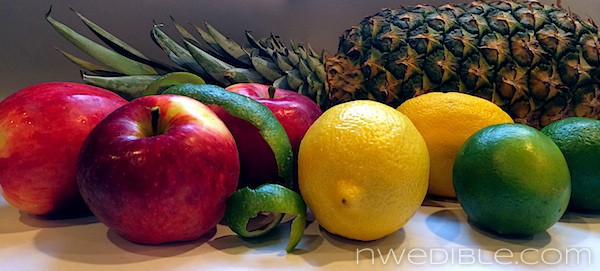
Alcohol is a fantastic solvent, and I suspect any residual pesticide or herbicide residues on your fruit will become a permanent part of your infusion. So I recommend organic or better fruit for infusions if possible.
Wash fruit. Peel if desired and appropriate. Apples and pears can be peeled or not, as you prefer. Discard any part of the fruit you wouldn’t eat: stems, cores, etc. Rough chop or slice large fruit.
Leave small fruits, like cherries, whole. I don’t bother pitting cherries. Gently fill your mason jar about half-full of chopped fruit or berries (don’t crush down) and top with your base.
For citrus, the zest is the part you really want. Remove any thick, bitter white pith and discard. The zest of a small grapefruit, one lemon or two limes will nicely infuse two cups of base. Typically I save the juice for another use.
Delicate fruit like raspberries will be spent after about a week or two, firm fruit like pineapple or green apple can handle longer. Citrus zest is good at 5 days to a week.
Again, taste frequently and decide what you like. I don’t think the fruit that comes out of an infusion is good for much, but some people like to eat the boozy dregs left after straining over ice cream or cake. To each their own. When the infusion is to your liking, strain and filter.
Dried Fruit
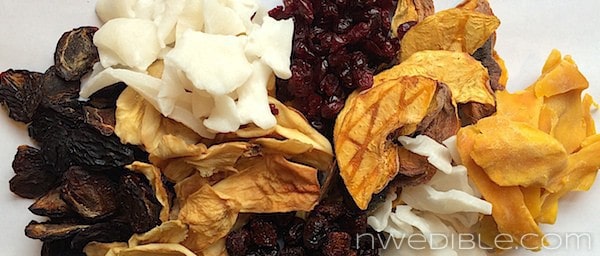
I love dried fruit infusions. They are fast and easy to make, and the resultant boozy plumped fruit is just as good as the just slightly syrupy infused base. Dried fruit gives flavor quickly, but you can’t really overinfuse it, so just mix it up and stick it away someplace out of the way.
I make something I call “Manhattan Cherries” by soaking dried cherries in a combination of bourbon and triple sec for…well…indefinitely, actually. We use the cherries, a few on a bamboo skewer, to garnish Manhattans. If you like commercial pear vodka, try soaking dried pears and a few slices of fresh peeled ginger in vodka and prepare to wonder how you ever lived without this infusion.
Use natural, untreated dried fruit without additives if possible. If using large dried fruit, like pear halves, rough chop if desired. Use a lightly packed half-cup of dried fruit per two cups of base. Drop dried fruit into a mason jar and top with base. Your jar should be a little less than half full.
Let infuse for a few days to several months, or until so delicious you can’t stand it anymore. Strain and filter. Taste your dried fruit – you may like it.
Nuts

Nuts are, if you’ll pardon the pun, a hard nut to crack. If you are going to embark on nut infusions, be prepared for a few extra steps. Not that caramelized walnut bourbon isn’t worth the effort, mind you. Because, OMG, it is.
If necessary, shell nuts. Nuts with skins on tend to lend tannic astringency to infusions. This astringency typically mellows with age, but for a minder infusion, blanch and skin nuts before using. This is easier said than done with nubbly nuts like walnuts and pecans, and I don’t bother. If you are using a golden or brown base liquor, the flavor of your nut infusion will be better if you toast the nuts until golden brown and delicious.
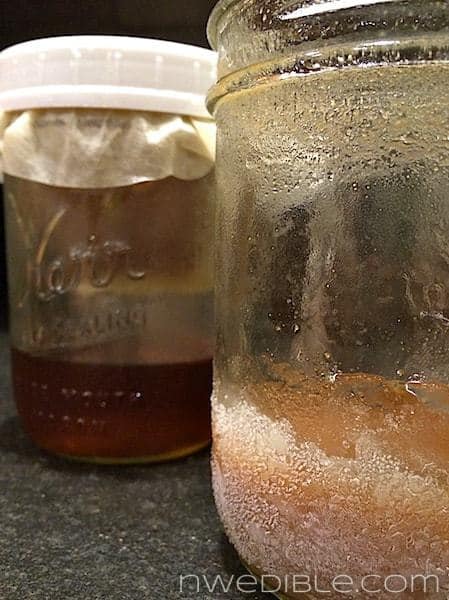
Rough chop nuts and add to your base at a ratio of 1 cup chopped nuts to 2 cups base. Let infuse a day or two. Taste and continue infusing if you desire. I generally go about a week. Strain and filter, then freeze your infusion overnight. This will allow any fat from the nuts to rise and solidify. Filter your infusion again through a coffee filter. Be prepared for the draining to take a little time. This technique is called fat washing and is necessary when infusing ingredients with any oil content of note.
Spices, Dry Goods & Similar
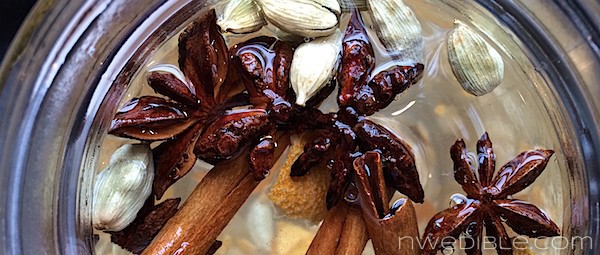
Spice infusions are as easy as it gets. Drop dried spices in jar, add booze. Wait. Always use whole, not ground spices. The cookie spices tend to do well if you want a warm, cozy, Christmasy flavored infusion. Fennel is always nice. Vanilla beans are lovely, and for the most flavorful extraction should be split lengthwise before use.
One vanilla bean is generally plenty unless you are making an extract – they are potent! Beware of cloves and cinnamon stick, which will dominate if overused.
Don’t be afraid to mix up combinations to your taste. If you love Bloody Mary’s, try a dill and celery seed infused vodka as your base. Throw a jalapeno or dried red chili in there too if you like it spicy. Chai spices and black tea can infuse a vodka for a killer Chai White Russian. I typically end up with 1-3 tablespoons of whole spices per cup of base.
Loose black and green tea, or high quality teas left in the little tea bag, can be added to your base. I have a green tea apple gin coming along nicely right now. Use 1 tablespoons loose tea or 2 teabags per 2 cups base.
Coffee should be lightly crushed but not ground and added to your base at ½ – 1 cup of coffee beans per 2 cups base, depending on how strong a coffee flavor you want.
Cocoa nibs are how you infuse booze with a chocolate flavor. Do not attempt cocoa powder or a hunk of baking chocolate. You’ll be disappointed. A half-cup of nibs to 2 cups of base works well.
With spice and dry goods infusions like these, taste frequently. As short as an hour may be long enough to get a nice subtle infusion for tea or strong spices.
If the spice is a complement to something else, like a dried apple and cinnamon rum, keep the spice quantities very moderate, or infuse the booze in stages. For example, start with the dried apple infusion, and let that go for two weeks or until you are happy with the flavor, then strain and infuse the apple rum with a cinnamon stick for a few days, or until you like the warmth of the cinnamon.
Vegetables, Roots, Herbs & Flowers
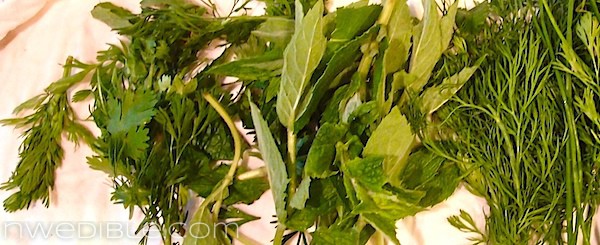
As with fruit, organic is better. Wash or scrub as appropriate. Root vegetables should be peeled and well trimmed. Anything particularly earthy can leave your base dirty tasting. Vegetables should infuse three days to a week. Taste often. Cucumber, beet, carrot and horseradish are all popular vegetable infusion ingredients.
Chop your vegetable into bite-size hunks or slices. Spicy peppers can be added whole (pierce a few times with the tip of a knife) or halved. If you want pepper flavor with less heat, remove seeds and ribs from fresh peppers before infusing.
Herbs and edible flowers should be rinsed and patted dry. The soft leafy herbs can be added in long sprigs and in fairly generous quantities. Strong flavored, woody herbs like rosemary should be used very carefully.
Some flowers have very distinctive flavors. If you aren’t confident about the flavor or strength of your edible flowers, go easy. A little lavender can add an enchanting backdrop to an infusion. Too much and you’re drinking a soap cocktail.
I think most herbal and floral flavors do best in combination with other flavors. Think blackberry-rose tequila, strawberry-basil vodka or tangerine-bronze fennel gin. However, most fresh herbs peak at about 4 days of infusing. If you are combining herbs or flowers with another “main” flavor, I recommend starting your main infusion a few days before and adding the herbal component a bit later.
Part Three: Infusing Your Booze (Putting it all Together)
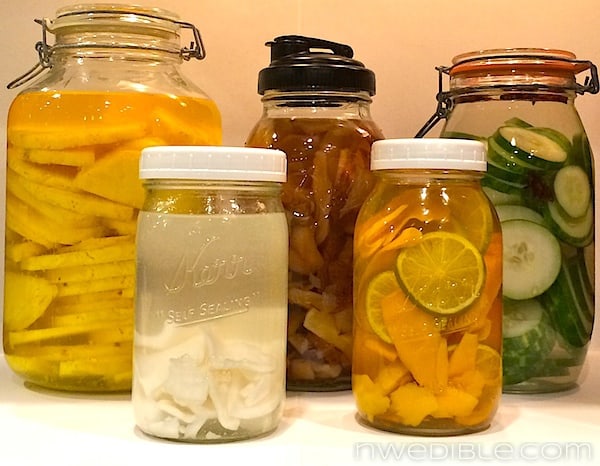
Once you’ve picked a base and your infusion ingredients, it’s easy as can be.
1. Prep & Mix
Once you have a flavor combo in mind, simply prepare your infusion ingredients and add them to a spotlessly clean mason jar. I like to use pints for experimental stuff and quarts for more proven flavor pairings. Generally, I use wide mouth jars. Top your infusion ingredient with your base, lid your mason jar tightly and set your jar in a cool, dark place.
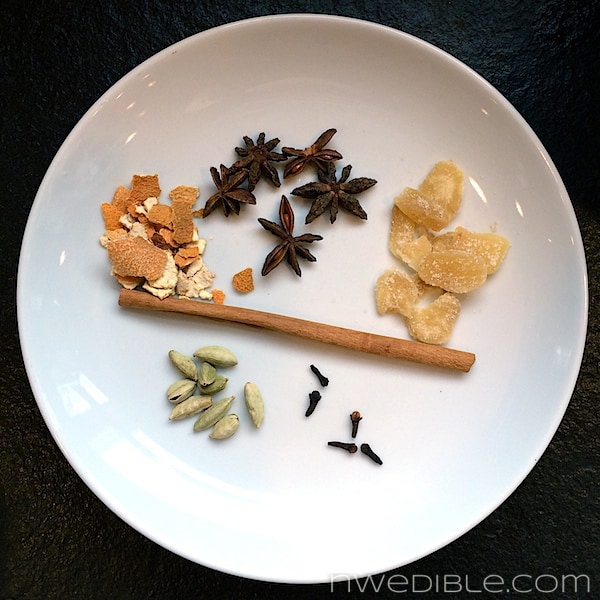
2. Shake
Once a day or more often if you can manage, give your jar a little shake to help the flavors meld. Taste your infusion daily or every few days, depending on how it’s coming along.
3. Wait
There’s quite a range of recommended infusion times out there, and the bottom line is that a booze infusion is done when it tastes good to you. That’s it.
For fresh ingredients, a week of infusion is a good rule of thumb. I tend to infuse for a week or two, but have left fresh peaches in bourbon and fresh cherries in vodka for several months to good effect. Some infusions – anything with dried fruit – can handle longer aging, and we made a lemongrass vodka that took two years to get really good.
But some concoctions, particularly spice or tea infusions or anything involving chili peppers, can get overstrong in a hurry. Alcohol extracts more of the bitter notes from things like coffee, tea, cocoa, herbs and spices, so take some care with strong flavored infusion components and taste frequently. A shorter infusion time with a greater quantity of infusables will tend to give you a more straightforward and less bitter flavor. Longer infusions with smaller quantities of infusables will be more complex but should be watched for developing bitterness or unpleasant flavors.
4. Strain & Filter
When your infusion is done to your taste, strain it through a kitchen strainer to remove anything chunky, then filter through a coffee filter, very fine mesh tea strainer or several layers of fine cheesecloth to remove residual sediment.
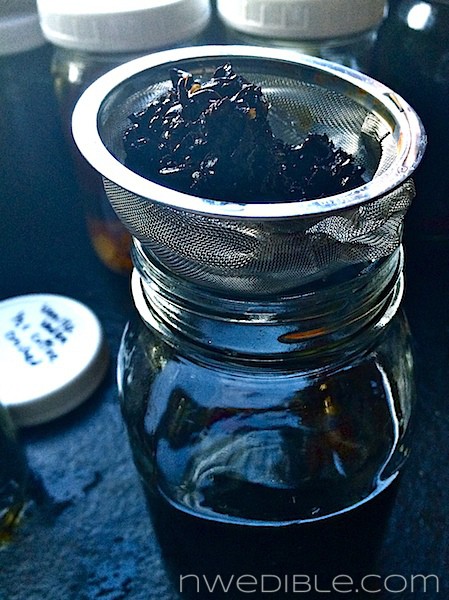
5. Use
Bottle your infusion into a pretty bottle or a clean mason jar. Lid tightly, label and store someplace dark and cool. Once well strained, booze infusions made with fresh ingredients will last several months in the refrigerator. Those made exclusively with dried ingredients like spices or coffee beans will keep pretty much indefinitely and don’t require refrigeration.
Enjoy deliciously, and responsibly.
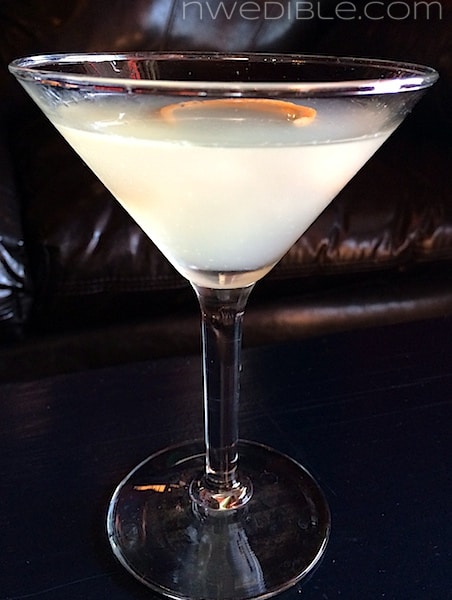
Part Four: Miscellany
The addition of sugar will turn your infused liquor into a liqueur. If you are looking for a sweeter and slightly syrupy result, add 1 to 2 tablespoons sugar or brown sugar per cup of base to your mix.
For lots and lots of DIY booze infusion specific ideas and posts, I highly recommend the website Boozed and Infused.
My favorite bartending books are Cocktail: The Drinks Bible For The Twenty-first Century (now sadly out of print and so grossly overpriced, but keep your eyes peeled at used bookstores) and The Ultimate Bar Book, which has a formula for pretty much every drink you can think of.
My favorite bartending website is Jeff Morgenthaler’s opinionated online booze tome out of Portland, JeffreyMorgenthaler.com. I also love the recipes and videos coming from Small Screen Network.
Happy Infusing! Cheers!
Do you infuse your booze? What are your favorite flavor infusions?
276
oops. that was supposed to say whipping cream VODKA
Hi there all you infusers out there. This is a great page and many thanks for taking to time to write it all up. I’ve made a few infusions over the years including the good old injecting vodka into watermelons and so on! Intend giving the grapefruit and ginger gin a go but wondering just how much ginger to put in. Don’t want to completely overpower it. Anyone done so for a standard 75cl/750ml bottle? How long did you leave it?
Does anyone know anything about the sugars? I’d use almond and coconut infused Jim Beam to add to a base of PG/VG to make my own flavoured e-cigarette liquid. The problem is that sugars burn at the same temperature as liquids evaporate creating possibly toxic smoke…
These look great! Definitely trying this out – and I’ve featured this page on my blog, http://messandfumblings.com/2015/04/03/infusing-oil-and-booze/
Thanks!
Thank you so much for this post!
I tried infusing basil vodka. The reason being, I LOVE basil, yet I’m not able to find a commercial brand in a B&M store (yes, I live in NYC.) I don’t like to experiment with food or alcohol, because I hate to waste.
For the second time in a row, I messed it up after following recipes word-for-word! The first time, I left it five days, shaking twice a day — way too long, it smelled atrocious! This time, I left it for about 2.5 days. I went maybe 18 hours without shaking it once. I strained it, and now I’m left with a brown, licorice-scented liquid that I’m afraid to taste. It’s in the freezer now.
I cleaned and dried the organic basil. Where may have I gone wrong? I don’t think I’ll be trying this again. What a shame, because I wanted to try infusing peanuts and sausages (separately!)
I’ve been making cucumber jalapeño gin lately. This is a quick 24 he infusion (take the jalapeño out earlier for less spice). I also just put 2 sliced peaches into a jar of Jim Beam Black and am waiting about 4 weeks for that to be ready. This afternoon my first attempt at dill pickle vodka should be ready. I live a dirty martini and can’t wait to try what I’m going to call “The Dirty Dill”.
Have you infused anything with watercress? Any tips will be appreciated.
This would be a good use of spoiled berries? I have some old blue berries, they have the flavor and some bacteria. Would it be a good idea to use them for infusing Vodka vs. throwing them out?
No – don’t use spoiled berries. The infusion will not improve the quality, and you’ll waste vodka. Just compost. Sorry!
I just found this wonderful site, and am new to infusing. I was thinking of trying an Apple-Pecan-Coffee infused Gold Rum:
1.75LTR Bacardi Gold
1 c dried apples
1 c toasted pecans (with some of the skins rubbed off after toasting)
1/8 c broken coffee beans in a cheese cloth infuser bag
Infuse for two days and remove the coffee beans. (Dry them on low in the oven, grind and make a pot of coffee. )
Continue the infusion for two weeks, then fat wash.
Can anybody suggest any improvements or infusion advice?
And no, I don’t want to add any sugar, but I am up for spices.
Thanks, Mike
Honestly I’d skip the coffee initially and would test run with a smaller quantity before going all in with a 1.75. Flavor wise, I like the apple pecan vision a lot – a very short in partial infusion with cinnamon would be a good add with that, too. My only concern is that coffee – I think even with a very short infusion you could lose the apple and pecan flavor. Not saying don’t do it, but test it in smaller portions first, or only infuse maybe a cup of your bacardi with coffee, then add the coffee infusion a tablespoon at a time to the larger infusion until the flavor is as you like it. This minimizing the risk of the coffee calling all the shots.
I’ve been infusing lemons for 20 years now for use in homemade Italian lemoncello as Christmas present and before it became popular. Your article just opened up new possibilities. Thank you.
I would love to try to make my own bourbon/Drambuie type flavor infusion. Cheap 100 proof bourbon (Evan Williams bottled in bond ideally), heather honey and spices and stuff like that would be nice too. This looks like it would be a fun hobby for this whiskey fan to get into. I love whiskey, plain and unflavored and flavored whiskey as well. It would be nice to not have to guess what bottle of “honey flavored whiskey” might have in it that’s not so natural even though what’s on the label may say “natural flavoring and other natural flavor’s.” That could be anything they want it to be at that point. Whiskey legally has to be made from pure natural ingredients which is nice to know on that part and I’d rather my flavoring be from natural ingredients as well :). I think when I get a nice paycheck, I’ll grab me a couple bottles of Evan Williams 100 proof bourbon whiskey, order some heather honey online and do some more research on what else I could ad, this could be fun.
I use lemon infused Everclear and add simple syrup to make a killer Lemoncello
I actually use Lemon zest only
I made some pineapple rum for when I went to Glastonbury last year. Brilliant stuff to drink straight if you do it for long enough and swap out the pineapple a couple of times.
I have a question though – this year I’ve done the same before transferring it through filter paper into a plastic drinks bottle. Only this time it’s gone fizzy after 24 hours. I left half of it in the jug because it didn’t fit and that’s still flat. What’s the deal – why has that happened and is the fizzy stuff ok to drink?
I am interested in making NY own flavored liquors.I hope this site will help, it already gave a good glance.
I’m looking for suggestions on infusions for a special vodka I’ve acquired. I have a couple ideas, but am open to other ideas! The vodka is Pau Maui oaked vodka. It’s handmade and distilled from pineapple. This is a limited quantity batch crafted with French oak, so it has a rich flavor. I already have a habanero infusion going. What else? Reading this gave me some ideas…(1) saffron cardamom? (2) vanilla? (3) ginger pear (4) fennel (5) dill and celery seed?
What’s the best alcohol to infuse with blueberries? I got a great price on a flat and thought this would be a good idea.
Hi! Great post. We came back from Ile de la Reunion with a spice and dried fruit mixture for infusing rum. It was wonderful and now we’re wondering if we can reuse the spice mix? We’ve poured the infused rum into a new bottle and have the drenched herbs left. Have you ever reused infusion ingredients? Would you absolutely recommend against for any reason? Also, can leaves or or dried fruit go moldy if they aren’t completely submerged? Thanks so much.
Good information. Lucky me I recently found your website by accident (stumbleupon).
I have book marked it for later!
When you’ve strained nuts out of your alcohol, toss them onto ice cream, melted chocolate, or make a boozy nut butter!
Hello from a Cornish guy living in Brittany. I’ve got some dried elecampane root that I grew in my garden and was wondering if there were any infusion recipes that you knew of. I’ve got about 30 or so other aromatics in garden so any infusion ideas would be appreciated.
Cheers
Philip
Hi I tried to make a mint-infused liqueur, and so far I’m not happy with the results. I used a liter of vodka and over a pound pof mint leaves. Unfortunately, the tannins in the mint leaves overwhelm the mintiness. It’s extremely minty! But even more extremely tannin-y. To coin a phrase. Also, the tannins give it a lovely brown color, like iced tea. Not what I was going for unfortunately! I know I could add green food coloring, but green + brown = ugly.
Anyway I was wondering how to lessen, or completely remove the tannins? I want to lessen the flavor AND the color. Is there something I can add which will precipitate out the tannins? Or would you recommend re-distilling? Charcoal filtering?
I’d love to hear your thoughts on the matter.
I don’t know about how to fix the color–my lilac liqueur had the same issue–but using dried mint and a shorter infusing time might help with the flavor.
Are you not concerned with alcohol evaporation during coffee-filter straining, since it is so slow? Particularly if working with overproofed bases. What is the best way of setting this up to minimize this?
Ugh, sorry, meant that to be a stand-alone comment, not part of this sub-thread.
Thank you for this information. Very informative and well-written.
Once you infuse with orange or lemon peel … can you candy the peel later? I hate to waste it.
yes.tried to once. didn’t work for me.
So i tried candying the ginormous pile of peel after i infused a gallon of everclear with orange, ginger, vanilla beans and other spices. it and it actually came out great. A lot of sugar and orange juice to completely cover. But i forgot it was in the stove and it ended up simmering 2+ hours. Not sure how it happened but the alcohol from the everclear ended up as bitter foam. Once i skimmed it… wow. The resulting syrup has the consistency of honey. And i tossed the orange and ginger with sugar and stuck it in the cold oven to dry out away from sticky fingers. Now i just have to figure out the best way to store it and what to do with it. I’m thinking orange ginger snaps? Orange Pecan Shortbread?
Real fruitcake (not made with shitty neon store-bought candied fruit) is actually quite nice. Or, if the strips of peel are thick/solid enough & shaped right, dip in chocolate to make candies.
Great ideas. Not thick enough for chocolate but getting ready to do more and will try do thick enough for that.
since, so far I got to the tequila -I was lookin for the strawberry. haven’t tried it with the mint. i’ve been bartending 20+ years, and just found the tequila rose! oh my gosh! cats meow(for me anyway) I haven’t even looked for a drink recipe. a rock glass,couple of ice cubes, and pour to the top! and yum. I had to use real strawberrys(pureed) then on to pudding shots. i’m sure the tequila rose is top shelf. i’m a bottom shelf gal now days.
Hi, I would like to infuse , but don’t know the measurements, white rum, sugar cane, vanilla stick, and leetchi (litchi fruit). please help. thank you.
I thought that this article was good but it fell short on a discussion about the percent of alcohol that is used in the infusion. The State of Ohio regulates the percent that is available and you can’t purchase anything over 80 proof. I have to go to Kentucky or Indiana for higher proof alcohol such as Everclear. In my experience, if you add a heavy syrup to your infused liquor (such as limoncello) you need to use a higher proof alcohol to start with so when you cut it with a syrup you still have a zippy liqueur. I tend to serve cordials after dinner instead of mixed drinks. Maybe it doesn’t matter that much for most things.
Thank you for writing!